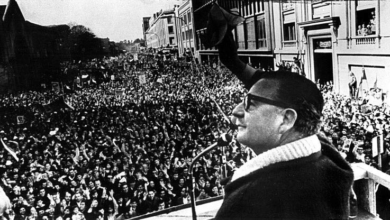On Oct. 30, 1950, the Puerto Rican independence cry of “Que viva Puerto Rico libre” resounded for the whole island to hear. On that day, Puerto Rican nationalists staged daring armed actions throughout the country in an attempt to break free from the stranglehold of U.S. colonialism, which began with military invasion in 1898.
|
Following the end of World War II, national liberation struggles sprang up on every continent. These anti-colonial mass upsurges in Africa, Asia and Latin America—many of which gravitated towards socialism—revealed the great vulnerability of imperialism.
In the United States, these developments put the ruling class in a state of intense apprehension and fear. After the 1949 Chinese Revolution, when the world’s largest country “went red,” the U.S. ruling class chose to unleash an anti-communist, anti-labor and racist witch hunt spearheaded by the notorious Senator Joseph McCarthy.
One often overlooked chapter in the history of the McCarthy witch hunt was its implementation in Puerto Rico. Under the cover of the fighting the “war on communism,” the U.S. colonial authority issued orders to jail and kill Puerto Rican nationalists.
Intelligence operatives of the Nationalist Party discovered that the Pentagon was gearing up to execute a plan for destroying the independence movement. The revolutionary leaders discussed all options to counter colonialism’s intentions. Campos and the Nationalist leadership decided not to wait for the onslaught, instead choosing to strike the first blow.
On the morning of Oct. 30, 1950, a woman named Blanca Canales, a Jayuya resident who had first-hand knowledge of the peoples’ despise for the colonial police, led a contingent of armed Nationalists against the city’s police. A battle ensued at the police headquarters. The bold Nationalists eventually overpowered the barricaded uniformed officials, forcing them to surrender and leave the police station with their hands raised in the air.
Canales then addressed the inhabitants of Jayuya, proclaimed the independence of Puerto Rico, raised the Puerto Rican flag (which was strictly forbidden under colonial law) and issued a command for the hated police station to be burned down.
Violent clashes between the colonial authorities and Nationalists also occurred in Utuado, Ponce, Mayag?ez, Arecibo, Naranjito, Ciales, Pe?uelas and other cities. In San Juan, the police attacked the headquarters of the Nationalist Party. In defense of their office building, Dr. Pedro Albizu Campos and others engaged the police and National Guard in a gun battle until the Nationalists were overcome by tear gas.
The National Guard and police surrounded Jayuya in order to suppress the rebellion. The U.S. colonizers conducted aerial bombings of Jayuya and destroyed most of the city. Throughout Puerto Rico the U.S. military imposed martial law. Nationalists and anyone who sympathized with the cause for independence were rounded up by the repressive agencies of colonialism.
Well aware of the potential political impact of the rebellion, the U.S. government imposed a news blackout, preventing the world from hearing about the rebellion and repression. To silence the voice of the emerging struggle, there was a gradual but intense effort to twist the facts. Then President Harry S. Truman falsely characterized the conflict as “between Puerto Ricans.”
Dr. Pedro Albizu Campos then sent Puerto Rican Nationalists Oscar Collazo and Griselio Torresola to the Blair House in Washington, D.C. to assassinate Truman. Torresola was killed and Collazo was critically wounded in a shootout with capital police and Truman’s bodyguards. Collazo was initially sentenced to death, but based on the strength of the movement for Puerto Rican independence, Truman commuted his sentence and he was eventually freed in 1979.
Although the rebellion failed militarily and the movement suffered severe repression, the Jayuya Uprising nevertheless added to the historical national dignity of a colonized people in struggle.
The legacy of the U.S. colonial presence in Puerto Rico is one of degradation and plunder. As Jayuya shows, the Puerto Rican masses are destined to make their contribution to the ultimate destruction of U.S. imperialism. Que viva Puerto Rico libre!







